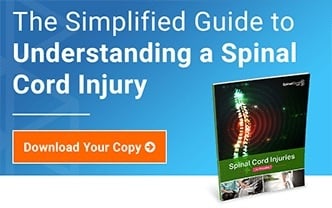What Is a Spinal Lesion? Symptoms and Treatment
It can be overwhelming at the best of times to understand and comprehend scientific jargon from doctors and other medical professionals. Some words are ingrained into us with certain negative connotations, such as tumors, lesions, and cancers. These terms are generally known in modern culture, even if most people don't know much about their specifics.
Knowing what a doctor means can be a difficult task, and some doctors may be better than others at breaking diagnoses down into bite size, and most importantly, understandable chunks. This article will look into what doctors mean by ‘spinal lesions’.
What Is a Spinal Lesion?

Put simply, a lesion is the name given to an abnormal change which occurs to any tissue or organ, caused by a disease or injury. The abnormal growths of tissue can occur from some form of trauma, including an accident, spinal cord injury, or serious infections, such as syphilis or HIV (Rubin). These tissue abnormalities along the spine can be isolated or supporting tissues may also be damaged. In many cases, any change to cells can be referred to as tumors.
The different kinds of spinal lesions can cause a wide array of dysfunctions — such as motor and sensory deficits. Spinal lesions can be either benign or malignant depending on their severity, location, and if they're caused caused by cancers of the spine such as osteosarcoma or osteochondroma.
What Are the Signs and Symptoms of a Spinal Lesion?
Spinal cord lesions can present different symptoms depending upon the location of the lesion itself. There are several syndromes that can result from these lesions which will affect different motor skills and abilities. For example, spinal lesions can add pressure to areas of the spine which cause chronic pain and impairment to an individual’s daily life.
Some signs of a lesion of the spine include:
- Pain;
- Weakness in shoulders and wrists:
- Loss of bicep jerk reflex:
- Horner Syndrome; and
- Paralysis in the hands and legs.
These are to name just a few, and as previously noted, these will depend upon location of lesion. Other physical signifiers of spinal lesions can be palpable masses under the skin which appear along the spinal cord on the back.
The most accurate way to test for spinal cord disorders and lesions is an MRI exam, which can show tumors, spinal disk abnormalities, abscesses, and more. This can help determine the severity and location of lesions, which will then help to identify any potential treatments and prognoses.
Treatment and Prognosis
Because a spinal lesion can cover many kinds of diagnoses, there are varying forms of treatment and different prognoses an individual can have. A lesion is categorized dependent upon its size and location. For example, lesions of the spine are referred to as central lesions because of their impact on the central nervous system.
Treatment is key for spinal tumors, as any damage they cause can be made more severe (or even permanent) if treatment is not sought soon enough. The University of Pittsburgh Medical Center (UPMC) have pioneered treatment for a variety of spinal lesions, including Meningioma, Neurofibroma, Metastatic tumor and Schwannoma.
As previously discussed, patients with these kinds of conditions require the most tailored treatment as every body can react differently to spinal lesions. Although there are trends of cellular behavior within these diagnoses, it is paramount patients learn all they can about their condition and how their body is working alongside it.
If you have been diagnosed recently with a form of spinal lesion, ensure you get as much information as you can on your condition. Although initially overwhelming, with the the right care treatment alongside self-education, you will be in a better position to heal, not to mention feel empowered through your treatment.
If you experience any abnormal pain, or find any new lumps or protrusions on your back, seek medical attention immediately.
Stay Updated on Advancements On Traumatic Brain &
Spinal Cord Injuries
About the Author





